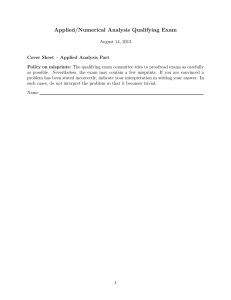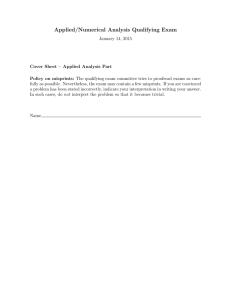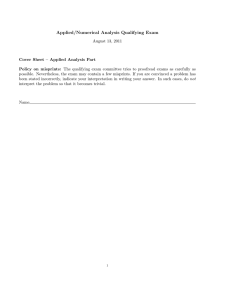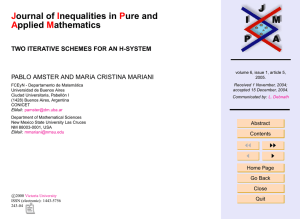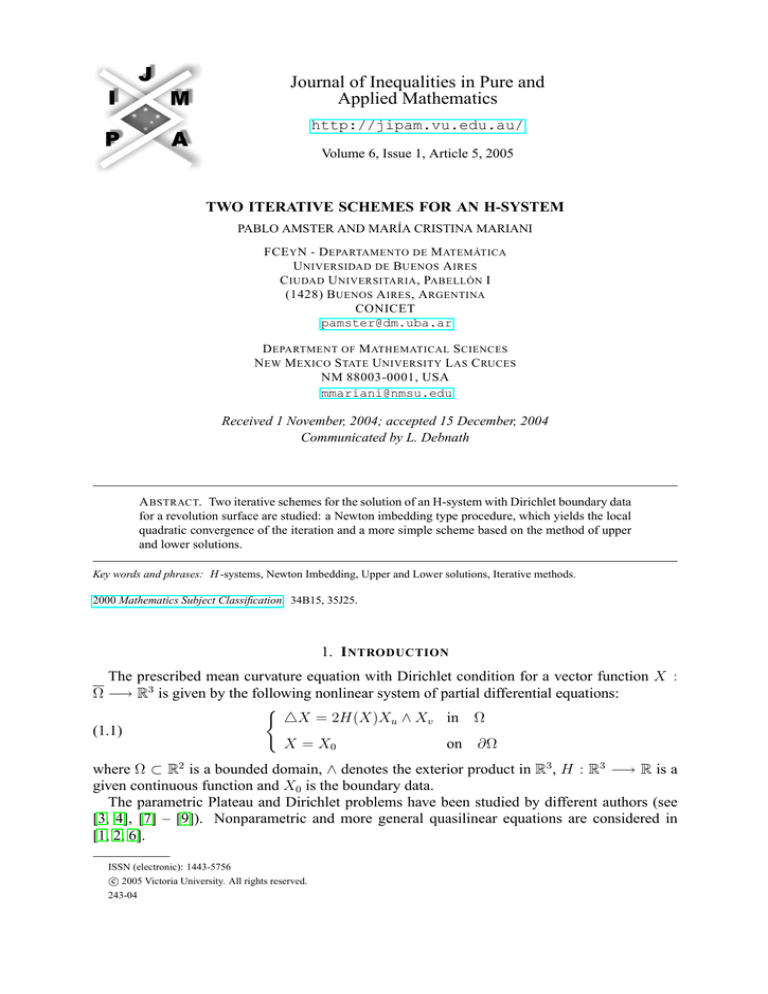
Journal of Inequalities in Pure and
Applied Mathematics
http://jipam.vu.edu.au/
Volume 6, Issue 1, Article 5, 2005
TWO ITERATIVE SCHEMES FOR AN H-SYSTEM
PABLO AMSTER AND MARÍA CRISTINA MARIANI
FCE Y N - D EPARTAMENTO DE M ATEMÁTICA
U NIVERSIDAD DE B UENOS A IRES
C IUDAD U NIVERSITARIA , PABELLÓN I
(1428) B UENOS A IRES , A RGENTINA
CONICET
pamster@dm.uba.ar
D EPARTMENT OF M ATHEMATICAL S CIENCES
N EW M EXICO S TATE U NIVERSITY L AS C RUCES
NM 88003-0001, USA
mmariani@nmsu.edu
Received 1 November, 2004; accepted 15 December, 2004
Communicated by L. Debnath
A BSTRACT. Two iterative schemes for the solution of an H-system with Dirichlet boundary data
for a revolution surface are studied: a Newton imbedding type procedure, which yields the local
quadratic convergence of the iteration and a more simple scheme based on the method of upper
and lower solutions.
Key words and phrases: H-systems, Newton Imbedding, Upper and Lower solutions, Iterative methods.
2000 Mathematics Subject Classification. 34B15, 35J25.
1. I NTRODUCTION
The prescribed mean curvature equation with Dirichlet condition for a vector function X :
Ω −→ R3 is given by the following nonlinear system of partial differential equations:
(
4X = 2H(X)Xu ∧ Xv in Ω
(1.1)
X = X0
on ∂Ω
where Ω ⊂ R2 is a bounded domain, ∧ denotes the exterior product in R3 , H : R3 −→ R is a
given continuous function and X0 is the boundary data.
The parametric Plateau and Dirichlet problems have been studied by different authors (see
[3, 4], [7] – [9]). Nonparametric and more general quasilinear equations are considered in
[1, 2, 6].
ISSN (electronic): 1443-5756
c 2005 Victoria University. All rights reserved.
243-04
2
PABLO A MSTER AND M ARÍA C RISTINA M ARIANI
We shall consider the particular case of a revolution surface
X(u, v) = (f (u) cos v, f (u) sin v, g(u))
with f, g ∈ C 2 (I) such that f > 0 and g 0 > 0 over the interval I ⊂ R. Without loss of
generality we may assume that I = (0, L), and problem (1.1) becomes
00
f − f = −2H(f, g)f g 0 in I
g 00 = 2H(f, g)f f 0
in I
(1.2)
f (L) = αL
f (0) = α0
g(0) = β0
g(L) = βL
where H : R2 −→ R is a given continuous function, and α0 , αL > 0, β0 < βL are fixed real
numbers.
It is easy to see that any solution of (1.2) verifies the equality
2
2
(f 0 ) + (g 0 ) = f 2 + c.
Hence, the isothermal condition
|Xu | − |Xv | = Xu Xv = 0
holds if and only if c = 0. In this case, H is the mean curvature of the surface parameterized by
X (see [8]).
We shall study problem (1.2) for a surface with connected boundary, namely
00
f − f = −2H(f, g)f g 0 in I
g 00 = 2H(f, g)f f 0
in I
(1.3)
f (L) = αL ,
g(L) = βL
f (0) = g 0 (0) = 0.
In particular, if H depends only on the radius f , from the equality
g 00 = 2H(f )f f 0 ,
g 0 (0) = 0,
g(L) = βL
Rt
e
problem (1.3) easily reduces to a single equation; indeed, if H(t)
= 0 sH(s)ds, the following
integral formula holds for g:
Z L
e (s))ds.
H(f
g(t) = βL − 2
t
Thus, problem (1.3) is equivalent to the equation
0
f 00 − f = −4H(f )f H(f
e ) = −2 H
e 2 (f )
(1.4)
f =α
in I
on ∂I
e
with α(t) := αLL t. We remark that if αL = 0 then g 0 (L) = 2H(0)
= 0, which corresponds to a
surface without boundary.
The paper is organized as follows. In Section 2, a Newton imbedding type procedure for
problem (1.4) is considered, which yields the local quadratic convergence of the iteration. In
Section 3 we construct a more simple convergent scheme based on the existence of an ordered
pair of a lower and an upper solution.
J. Inequal. Pure and Appl. Math., 6(1) Art. 5, 2005
http://jipam.vu.edu.au/
T WO I TERATIVE S CHEMES FOR AN H- SYSTEM
3
2. A N EWTON I MBEDDING T YPE P ROCEDURE
Throughout this section we shall assume the following condition:
00
1 + Lπ Lπ − δ0
2
e
(2.1)
H
(x) ≤
for − k ≤ x ≤ k + αL ,
2
where δ0 < Lπ and k satisfies:
0
1/2 2
e
kδ0 > L 2 H
(α) − α
2.
L
Remark 2.1. A straightforward application of Leray-Schauder degree theory proves that if
condition (2.1) holds then there exists at least one solution of (1.4), which is unique in the set
K = {u ∈ H 2 (I) : −k ≤ u ≤ k + αL }.
00
0
2
2
e
e
Remark 2.2. As H
(0) = 0 and 2 H (α) − α 2 → 0 for αL → 0, we deduce that
L
for any H there exists a positive number α∗ such that (2.1) holds when αL < α∗ .
In order to solve equation (1.4) in an iterative manner, we shall embed it in a family of
problems
0
f 00 + λ 2 H
e 2 (f ) − f = 0
(1.4λ )
f (0) = 0, f (L) = αL .
A simple computation shows that if Sλ is the semilinear operator given by
0
00
2
e
Sλ (f ) = f + λ 2 H (f ) − f ,
then the following estimate holds for any f, g ∈ K such that f = g on ∂I:
1
(2.2)
kf 0 − g 0 kL2 ≤ kSλ (f ) − Sλ (g)kL2 .
δ0
λ
Hence, if f is the (unique) solution of (1.4λ ) in K, we have that
0
1
1 λ
0
2
e
k(f − α) kL2 ≤ kSλ (α)kL2 ≤ 2 H
(α) − α
2.
δ0
δ0
L
0
1/2
e 2 (α) − αkL2 we obtain:
Thus, setting k0 = Lδ0 k2 H
−k0 ≤ f λ ≤ k0 + αL .
We first present a sketch of the method: given λ < 1, and assuming that f λ ∈ K is known,
we shall prove the existence of a positive ε and a recursive sequence {fn } which converges
quadratically to the unique solution of (1.4λ+ε ) in K. As ε can be chosen independently of f λ
and λ, starting at f 0 = α, we deduce the existence of a sequence
0 = λ0 < λ1 < · · · < λN = 1,
λk
where f ∈ K is obtained iteratively from f λk−1 .
Let λ < 1, and f λ ∈ K be a solution of (1.4λ ). Define the constants:
k − k0
R = 1/2 ,
L
0
λ
e 2 (f λ ) ,
k1 = f
−
2
H
2
J. Inequal. Pure and Appl. Math., 6(1) Art. 5, 2005
http://jipam.vu.edu.au/
4
PABLO A MSTER AND M ARÍA C RISTINA M ARIANI
k2 =
sup
−k≤ξ≤k+αL
2 000 e
H
(ξ)
and define a sequence {fn } in the following way:
• f0 := f λ .
• fn+1 the unique element of H 2 (I) that solves the linear problem
0
00
f 00 = (λ + ε) 1 − 2 H
2
2
e
e
(fn )
(fn ) (fn+1 − fn ) + fn − 2 H
n+1
fn+1 (0) = 0, fn+1 (L) = αL .
We shall prove that if ε is small enough, then {fn } is well defined. More precisely:
Theorem 2.3. Assume that (2.1) holds, and that H is twice continuously differentiable on
[−k, k + αL ]. Then {fn } is well defined and converges quadratically for the H 1 -norm to the
unique solution of (1.4λ+ε ) in K for any ε ≤ 1 − λ satisfying:
RL3/2 k2
δ0 R
ε 1+
<
.
πδ0
k1
Proof. As f0 ∈ K, f1 is well defined, and by an estimate analogous to (2.2) we obtain:
00
1 0
0
00
2
e
kf1 − f0 kL2 ≤ (f1 − f0 ) − (λ + ε) 1 − 2 H
(f0 ) (f1 − f0 )
2
δ0
L
0
ε
e 2 (f0 )
= f0 − 2 H
2
δ0
L
ε
= k1 ≤ R.
δ0
We shall assume as inductive hypothesis that fk is well defined for k = 1, . . . , n, and that
kfk0 − f00 kL2 ≤ R. Thus, fn ∈ K and fn+1 is well defined. Moreover, for k = 1, . . . , n we have
that
00
00
2
e
(fk+1 − fk ) − (λ + ε) 1 − 2 H
(fk ) (fk+1 − fk )
000
e 2 (ξk )(fk − fk−1 )2
= −(λ + ε) H
for some mean value ξk (x), and hence
k(fk+1 − fk )0 kL2 ≤
3/2
k2 (fk − fk−1 )2 2 ≤ k2 L k(fk − fk−1 )0 k2 2 .
L
L
δ0
δ0 π
By induction,
0
k(fk+1 − fk ) kL2 ≤
k2 L3/2
k(f1 − f0 )0 kL2
δ0 π
2k −1
k(f1 − f0 )0 kL2 ≤ A2
k −1
k(f1 − f0 )0 kL2 ,
where
A=
εk1 k2 L3/2
< 1.
δ02 π
Hence,
0
k(fn+1 − f0 ) kL2 ≤
n
X
k(fk+1 − fk )0 kL2 ≤
k=0
J. Inequal. Pure and Appl. Math., 6(1) Art. 5, 2005
1
εk1
k(f1 − f0 )0 kL2 ≤
.
1−A
δ0 (1 − A)
http://jipam.vu.edu.au/
T WO I TERATIVE S CHEMES FOR AN H- SYSTEM
5
By hypothesis, we conclude that k(fn+1 − f0 )0 kL2 ≤ R. Thus, fn is well defined for every n,
and the inequality
n
k(fn+1 − fn )0 kL2 ≤ A2 −1 k(f1 − f0 )0 kL2
holds, proving that {fn } is a Cauchy sequence in H 1 (I). Furthermore, if f = limn→∞ fn , it is
immediate that fn → f in H 2 (I), and f ∈ K solves (1.4λ+ε ).
Remark 2.4. A uniform choice of ε can be obtained if we set
0
1/2
2
e
x − 2 H
(x) .
k1 = L
sup
−k ≤x≤k +α
0
0
L
3. U PPER AND L OWER S OLUTIONS FOR P ROBLEM (1.4)
In this section we define a convergent sequence based on the existence of an upper solution
of the problem: namely, a nonnegative function β such that
0
00
e 2 (β),
β(L) ≥ αL .
(3.1)
β − β ≤ −2 H
We remark that it suffices to consider this assumption, since 0 is a lower solution of (1.4).
Theorem 3.1. Assume that β ≥ 0 satisfies (3.1) and that H is continuously differentiable for
0 ≤ x ≤ kβk∞ . Set
00
e 2 (x)
C = 1 − 2 min
H
0≤x≤kβk∞
{fn± }
and define the sequences
• f0− ≡ 0
f0+ = β
given by:
±
• {fn+1
} the unique solution of the linear problem
0
(f ± )00 − Cf ± = (1 − C)f ± − 2 H
e 2 (f ± )
n+1
n+1
n
n
f ± = α on ∂I.
n+1
Then {fn− } (respectively {fn+ }) is nondecreasing (nonincreasing), and converges pointwise
to a solution of (1.2). Moreover, the respective limits f ± satisfy: 0 ≤ f − ≤ f + ≤ β.
Proof. Let us first note that C ≥ 0 (in fact, C ≥ 1), which implies that both sequences are
well defined. Furthermore,
from the choice of C, it is immediate that the function ψ(x) =
0
e 2 (x) is nonincreasing for 0 ≤ x ≤ kβk∞ . By definition,
(1 − C)x − 2 H
0
e 2 (β) ≥ β 00 − Cβ
(f1+ )00 − Cf1+ = (1 − C)β − 2 H
and using the maximum principle it follows that f1+ ≤ β. On the other hand,
(f1+ )00 − Cf1+ = ψ(β) ≤ ψ(0) = 0
and as f1+ ≥ 0 on ∂I we deduce that f1+ ≥ 0 over I. Assume as inductive hypothesis that
+
.
0 ≤ fn+ ≤ fn−1
Then
+
+
+
) = (fn+ )00 − Cfn+
= ψ(fn+ ) ≥ ψ(fn−1
)00 − Cfn+1
(fn+1
and
+
+
(fn+1
)00 − Cfn+1
= ψ(fn+ ) ≤ ψ(0) = 0
J. Inequal. Pure and Appl. Math., 6(1) Art. 5, 2005
http://jipam.vu.edu.au/
6
PABLO A MSTER AND M ARÍA C RISTINA M ARIANI
+
which implies that 0 ≤ fn+1
≤ fn+ . Thus, {fn+ } is nonincreasing and converges pointwise to a
function f + ≥ 0. By standard apriori estimates, we have that
+
+
+
− α)kL2 = ckψ(fn+ ) − αkL2 ≤ M
− α)00 − C(fn+1
− αkH 2 ≤ ck(fn+1
kfn+1
for some constant M . By compactness, {fn+ } admits a convergent subsequence in C 1 (I), proving that f + ∈ C 1 (I). Furthermore,
Z x
+
0
+
0
+
(fn+1 ) (x) − (fn+1 ) (0) =
Cfn+1
+ ψ(fn+ ),
0
and by dominated convergence we conclude that
Z x
Z
+ 0
+ 0
+
+
(f ) (x) − (f ) (0) =
Cf + ψ(f ) =
0
x
0
e 2 (f + ).
f+ − 2 H
0
Thus, the result follows. The proof is analogous for {fn− }.
As a simple consequence we have:
Corollary 3.2. Assume there exists a number k ≥ αL such that
1
e
H(k)H(k)
≤ .
4
Then β ≡ k is an upper solution, and the schemes defined in the previous theorem converge.
r
e
Example 3.1. For H(x) = rxn , we have that H(x)
= n+2
xn+2 , and the conditions of the
previous corollary hold for
1
n + 2 2n+2
αL ≤ k ≤
.
4r2
However, it is possible to find a sharper bound for αL , if we consider the parabola
"
2 #
x−L
β(x) = αL 1 −
.
L
Indeed, in this case we have that β is an upper solution if and only if
−
2αL
4r2 2n+3
−
β
≤
−
β
L2
n+2
or equivalently
2αL
L2
2
4r
for φ(x) = x n+2
x2n+2 − 1 . Note that for 0 ≤ x ≤ αL we have:
φ(β) ≤
φ(x) ≤ max{0, φ(αL )}.
Thus, it suffices to assume that
0<
αL2n+2
n+2
≤
4r2
2
1+ 2
L
.
Remark 3.3. In the previous example, equation (1.4) is superlinear, namely:
4r2 2n+3
f
− f = 0,
f (0) = 0, f (L) = αL .
n+2
It can be proved (see e.g. [5]) that this problem admits infinitely many solutions. More precisely,
there exists k0 ∈ N such that for any j > k0 the problem has at least two solutions crossing the
line α(t) = αLL t exactly j times in (0, L).
f 00 +
J. Inequal. Pure and Appl. Math., 6(1) Art. 5, 2005
http://jipam.vu.edu.au/
T WO I TERATIVE S CHEMES FOR AN H- SYSTEM
7
R EFERENCES
[1] P. AMSTER, M.M. CASSINELLI AND M.C. MARIANI, Solutions to general quasilinear elliptic
second order problems, Nonlinear Studies, 7(2) (2000), 283–289.
[2] P. AMSTER, M.M. CASSINELLI AND M.C. MARIANI, Solutions to quasilinear equations by an
iterative method, Bulletin of the Belgian Math. Society, 7 (2000), 435–441.
[3] P. AMSTER, M.M. CASSINELLI AND D.F RIAL, Existence and uniqueness of H-System’s solutions with Dirichlet conditions, Nonlinear Analysis, Theory, Methods, and Applications, 42(4)
(2000), 673–677.
[4] H. BREZIS AND J.M. CORON, Multiple solutions of H systems and Rellich’s conjecture, Comm.
Pure Appl. Math., 37 (1984), 149–187.
[5] A. CAPPIETO, J. MAWHIN AND F. ZANOLIN, Boundary value problems for forced superlinear
second order ordinary differential equations, Séminaire du Collége de France.
[6] D. GILBARG AND N.S. TRUDINGER, Elliptic Partial Differential Equations of Second Order,
Springer-Verlag (1983).
[7] S. HILDEBRANDT, On the Plateau problem for surfaces of constant mean curvature, Comm. Pure
Appl. Math., 23 (1970), 97–114.
[8] M. STRUWE, Plateau’s Problem and the Calculus of Variations, Lecture Notes, Princeton Univ.
Press (1988).
[9] GUOFANG WANG, The Dirichlet problem for the equation of prescribed mean curvature, Analyse
Nonlinéaire, 9 (1992), 643–655.
J. Inequal. Pure and Appl. Math., 6(1) Art. 5, 2005
http://jipam.vu.edu.au/



